Solved Problem on Rotational Kinematics
advertisement
The ABCD rod shown rotates on two spherical joints in A and D, in a clockwise
direction when viewed from the point of view A. The angular speed of the bar at the instant
considered is equal to 12 rad/s, and decreases at the rate of 3 rad/s2. Find:
a) The angular velocity, in rad/s;
b) The angular acceleration, in rad/s2;
c) The velocity of point B, in em m/s;
d) The acceleration of point B, in m/s2.
a) The angular velocity, in rad/s;
b) The angular acceleration, in rad/s2;
c) The velocity of point B, in em m/s;
d) The acceleration of point B, in m/s2.
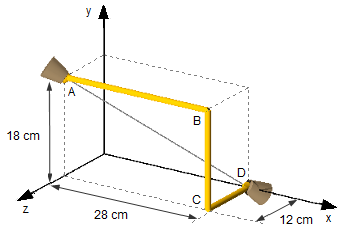
Problem data:
- Angular velocity: \( \omega =12\;\text{rad/s} \);
- Angular acceleration: \( \alpha =-3\;\text{rad/s} \).

Seen from point A the system rotates clockwise with angular velocity ω and as its angular acceleration α is negative it is counterclockwise (Figure 1).
Solution
First we convert the dimensions of the bar given in centimeters to meters used in the International System of Units (S.I.).
\[
\begin{gather}
\overline{AB}=28\times\frac{1\;\text{m}}{10^{2}}=28\times10^{-2}\;\text{m}=0.28\;\text{m}\\
\overline{BC}=18\times\frac{1\;\text{m}}{10^{2}}=18\times10^{-2}\;\text{m}=0.18\;\text{m}\\
\overline{CD}=12\times\frac{1\;\text{m}}{10^{2}}=12\times10^{-2}\;\text{m}=0.12\;\text{m}
\end{gather}
\]
a) Let us find the unit vector eAD in the direction of the axis AD represented
by the vector R around which the system rotates as a function of the unit vectors i,
j, k. The vector r' goes from the origin of the system to the point A that
has the coordinates
\( (\;x_{\mathrm{A}},y_{\mathrm{A}},z_{\mathrm{A}}\;)=(\;0,0.18,0.12\;) \),
the vector will be
\( \mathbf{r'}=0.18\;\mathbf{j}+0.12\;\mathbf{k} \).
The vector r goes from the origin to the point D that has the coordinates
\( (\;x_{\mathrm{D}},y_{\mathrm{D}},z_{\mathrm{D}}\;)=(\;0.28,0,0\;) \),
the vector will be
\( \mathbf{r}=0.28\;\mathbf{i} \).
The vector R will be (Figure 2)
\[
\begin{gather}
\mathbf{R}=\mathbf{r}-\mathbf{r'}\\
\mathbf{R}=0.28\;\mathbf{i}-(\;0.18\;\mathbf{j}+0.12\;\mathbf{k}\;)\\
\mathbf{R}=0.28\;\mathbf{i}-0.18\;\mathbf{j}-0.12\;\mathbf{k}
\end{gather}
\]
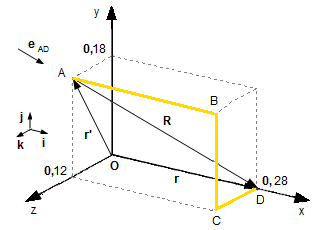
the unit vector eAD will be
\[
\begin{gather}
{\mathbf{e}}_{\mathrm{AD}}=\frac{\mathbf{R}}{|\mathbf{R}|}\\
{\mathbf{e}}_{\mathrm{AD}}=\frac{0.28\;\mathbf{i}-0.18\;\mathbf{j}-0.12\;\mathbf{k}}{\sqrt{\;0.28^{2}+(\;-0.18^{2}\;)+(\;-0.12^{2}\;)\;}}\\
{\mathbf{e}}_{\mathrm{AD}}=\frac{0.28\;\mathbf{i}-0.18\;\mathbf{j}-0.12\;\mathbf{k}}{\sqrt{\;0.0784+0.0324+0.0144\;}}\\
{\mathbf{e}}_{\mathrm{AD}}=\frac{0.28\;\mathbf{i}-0.18\;\mathbf{j}-0.12\;\mathbf{k}}{\sqrt{\;0.1252\;}}\\
{\mathbf{e}}_{\mathrm{AD}}=\frac{0.28\;\mathbf{i}-0.18\;\mathbf{j}-0.12\;\mathbf{k}}{0.3538}\\
{\mathbf{e}}_{\mathrm{AD}}=0.79\;\mathbf{i}-0.51\;\mathbf{j}-0.34\;\mathbf{k}
\end{gather}
\]
The angular velocity will be (Figure 3)
\[ \bbox[#99CCFF,10px]
{\boldsymbol{\omega}=\omega \;{\mathbf{e}}_{\mathrm{AD}}}
\]
\[
\boldsymbol{\omega}=12\times(0.79\;\mathbf{i}-0.51\;\mathbf{j}-0.34\;\mathbf{k})
\]
\[ \bbox[#FFCCCC,10px]
{\boldsymbol{\omega}=9.48\;\mathbf{i}-6.12\;\mathbf{j}-4.08\;\mathbf{k}} \tag{I}
\]
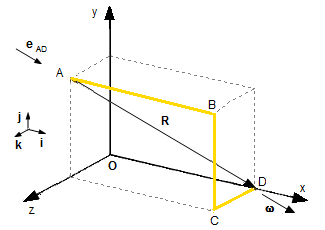
b) The angular acceleration will be (Figure 4)
\[ \bbox[#99CCFF,10px]
{\boldsymbol{\alpha }=\alpha \;{\mathbf{e}}_{\mathrm{AD}}}
\]
\[
\boldsymbol{\alpha}=-3\times(0.79\;\mathbf{i}-0.51\;\mathbf{j}-0.34\;\mathbf{k})
\]
\[ \bbox[#FFCCCC,10px]
{\boldsymbol{\alpha}=-2.37\;\mathbf{i}+1.53\;\mathbf{j}+1.02\;\mathbf{k}} \tag{II}
\]

c) The vector r' is the same used in item (a), the vector r goes from the origin of the system to the point B that has the coordinates \( (\;x_{\mathrm{B}},y_{\mathrm{B}},z_{\mathrm{B}}\;)=(\;0.28,0.18,0.12\;) \), the vector will be \( \mathbf{r}=0.28\mathbf{i}+0.18\;\mathbf{j}+0.12\;\mathbf{k} \). The vector rB that locates the point B, where we want to calculate the velocity, with respect to point A will be given by (Figure 5-A)
\[
\begin{align}
\mathbf{r}_{\mathrm{B}}=\mathbf{r}-\mathbf{{r'}} \qquad\qquad\qquad\qquad \\
\mathbf{r}_{\mathrm{B}}=0.28\mathbf{i}+0.18\;\mathbf{j}+0.12\;\mathbf{k}-(\;0.18\;\mathbf{j}+0.12\;\mathbf{k}\;)\\
\mathbf{r}_{\mathrm{B}}=0.28\mathbf{i}+0.18\;\mathbf{j}+0.12\;\mathbf{k}-0.18\;\mathbf{j}-0.12\;\mathbf{k} \;\; \\
\mathbf{r}_{\mathrm{B}}=0.28\mathbf{i} \qquad\qquad\qquad\qquad \tag{III}
\end{align}
\]
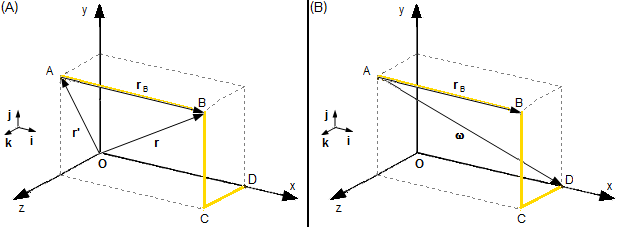
Using expression (I) the velocity of point B will be (Figure 5-B))
\[ \bbox[#99CCFF,10px]
{\mathbf{v}=\boldsymbol{\omega }\times\mathbf{r}_{\mathrm{B}}}
\]
\[
\begin{gather}
\mathbf{v}=\begin{bmatrix}
\mathbf{i}&\mathbf{j}&\mathbf{k}\\
\;9.48&-6.12&-4.08\\
\;0.28&0&0
\end{bmatrix}\\
\mathbf{v}=[(-6.12)\times0-(-4.08)\times0]\;\mathbf{i}-[\;9.48\times0-(-4.08)\times0.28]\;\mathbf{j}+[\;9.48\times0-(-6.12)\times0.28]\;\mathbf{k}\\
\mathbf{v}=[0-0]\;\mathbf{i}-[0-(\;-1.14\;)]\;\mathbf{j}+[0-(\;-1.71\;)]\;\mathbf{k}\\
\mathbf{v}=0\;\mathbf{i}-[1.14]\;\mathbf{j}+[1.71]\;\mathbf{k}
\end{gather}
\]
\[ \bbox[#FFCCCC,10px]
{\mathbf{v}=-1.14\;\mathbf{j}+1.71\;\mathbf{k}} \tag{IV}
\]
d) Using the vector rB of item (c) and expression (II), the acceleration at point
B will be (Figure 6)
\[ \bbox[#99CCFF,10px]
{\mathbf{a}=\boldsymbol{\omega }\times(\;\boldsymbol{\omega }\times\mathbf{r}_{\mathrm{B}}\;)+\boldsymbol{\alpha }\times\mathbf{r}_{\mathrm{B}}}
\]
The term inparentheses
\( (\;\boldsymbol{\omega}\times\mathbf{r}_{\mathrm{B}}\;) \)
is the velocity v found in item (c)
\[
\mathbf{a}=\boldsymbol{\omega }\times\mathbf{v}+\boldsymbol{\alpha}\times\mathbf{r}_{\mathrm{B}} \tag{V}
\]
By calculating the cross products separately
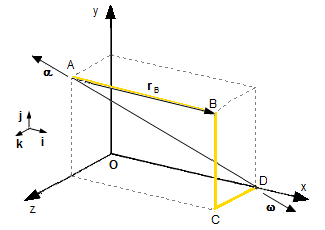
\[
\begin{align}
\boldsymbol{\omega}\times\mathbf{v}=\begin{bmatrix}
\mathbf{i}&\mathbf{j}&\mathbf{k}\\
9.48&-6.12&-4.08\\
0&-1.14&1.71
\end{bmatrix} \qquad\qquad\qquad\qquad\qquad \\
\boldsymbol{\omega}\times\mathbf{v}=[(-6.12)\times1.71-(-4.08)\times(-1.14)]\;\mathbf{i}\mathrm{-} \qquad\qquad\qquad\qquad\qquad \\
\qquad\qquad -[\;9.48\times1.71-(-4.08)\times0]\;\mathbf{j}+[\;9.48\times(-1.14)-(-6.12)\times0]\;\mathbf{k}\\
\boldsymbol{\omega}\times\mathbf{v}=[-10.47-4.65]\;\mathbf{i}-[16.21-0]\;\mathbf{j}+[-10.81-0]\;\mathbf{k} \qquad\quad\; \\
\boldsymbol{\omega}\times\mathbf{v}=-15.12\;\mathbf{i}-16.21\;\mathbf{j}-10.81\;\mathbf{k} \qquad\qquad\qquad\qquad\quad \tag{VI}
\end{align}
\]
\[
\begin{align}
\boldsymbol{\alpha }\times\mathbf{r}_{\mathrm{B}}=\begin{bmatrix}
\mathbf{i}&\mathbf{j}&\mathbf{k}\\
\;-2.37&1.53&1.02\\
0.28&0&0
\end{bmatrix} \qquad\qquad\qquad\quad\;\; \\
\boldsymbol{\alpha}\times\mathbf{r}_{\mathrm{B}}=[\;1.53\times0-1.02\times0\;]\;\mathbf{i}\mathrm{-} \qquad\qquad\qquad\qquad\qquad\qquad\qquad \\
\qquad -[(-2.37)\times0-1.02\times0.28]\;\mathbf{j}+[(-2.37)\times0-1.53\times0.28]\;\mathbf{k}\\
\boldsymbol{\alpha}\times\mathbf{r}_{\mathrm{B}}=[0-0]\;\mathbf{i}-[0-0.29]\;\mathbf{j}+[0-0.43]\;\mathbf{k} \qquad\qquad\quad \\
\boldsymbol{\alpha}\times\mathbf{r}_{\mathrm{B}}=0.29\;\mathbf{j}-0.43\;\mathbf{k} \qquad\qquad\qquad\qquad\qquad \tag{VII}
\end{align}
\]
substituting expressions (VI) and (VII) in (V) the acceleration will be
\[
\mathbf{a}=(\;-15.12\;\mathbf{i}-16.21\;\mathbf{j}-10.81\;\mathbf{k}\;)+(\;0.29\;\mathbf{j}-0.43\;\mathbf{\;})\mathbf{k}
\]
\[ \bbox[#FFCCCC,10px]
{\mathbf{a}=-15.12\;\mathbf{i}-15.92\;\mathbf{j}+11.24\;\mathbf{k}}
\]
advertisement

Fisicaexe - Physics Solved Problems by Elcio Brandani Mondadori is licensed under a Creative Commons Attribution-NonCommercial-ShareAlike 4.0 International License .